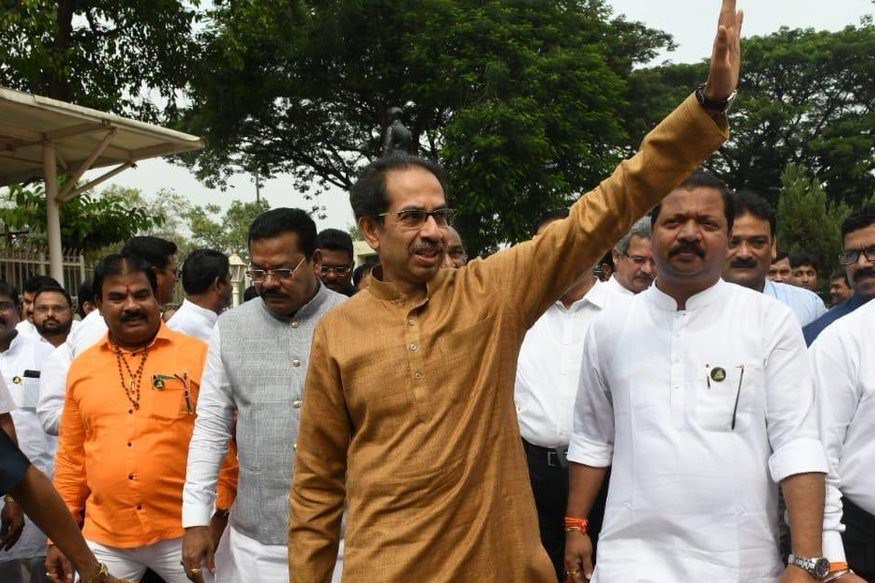The formation of the Maha Vikas Aghadi coalition government has raised the seminal question whether the coming together of three major opposition parties – the Sena, the NCP and the Congress – in the important state of Maharashtra can be a turning point in Indian politics.
The coalition at present many feel is held together by anti-BJPism particularly after the BJP’s crude grab for power, and their desire to form the government in Maharashtra, the finance capital of India. There is already considerable debate in the media of how long such a coalition will last.
There still remain considerable differences over power sharing between the three partners over posts such as the Deputy Chief Ministership, the Speaker as well as distribution of portfolios. The Congress does not want the Speakership, rather it’s demanding Deputy Chief Ministership.
Also, there remain differences over whether Ajit Pawar should be rehabilitated and made Deputy Chief Minister, given some other portfolio, or kept out. While senior NCP leader Sharad Pawar seems keen to bring him back, the Congress has reservations, some of which have been openly voiced by leaders such as Prithviraj Chavan. The question is complicated by the close relationship that the Thackerays and Pawars over generations have long enjoyed– the most important being the relationship between Bal Thackeray and Sharad Pawar – both in politics and in family ties. The Congress, on the other hand has a history of conflict with both Sharad Pawar and Sena leaders.
Critical ideological division:
However, the political differences over posts can be ironed out by leaders of the three parties. A far more critical division between the partners is the ideology of Hindutva espoused by the Sena.
The BJP and the Sena were partners for about 30 years in Maharashtra; this common ideology formed the basis for the functioning of BJP-Sena governments.
The B.N. Srikrishna Commission, which probed the causes of the Mumbai riots of 1992-93 following the destruction of the Babri Masjid that killed 900 people with majority being Muslims, named Shiv Sena leader Bal Thackeray in its report. The commission said the second phase of riots was “taken over by Shiv Sena and its leaders who continued to whip up communal frenzy by their statements and acts and writings and directives issued by the Shiv Sena Pramukh Bal Thackeray”. The nativistic politics of the party against outsiders is also well known.

The Aghadi partners have made attempts in their discussions to address this major ideological difference. On the insistence of the Congress, the Sena has agreed to take a pragmatic stand. Accordingly, the preamble of the Common Minimum Programme (CMP) states that the alliance partners commit to upholding the secular values enshrined in the Constitution. Further, that on all contentious national and state issues that impact on the secular fabric of the nation, they will take a joint view based on consultations and arrive at a consensus.
Today’s Shiv Sena, the party insists, has left behind the politics of xenophobia and ‘othering’ and wants everybody’s votes, including those of Muslims.
The party has been moderating itself since the death of Bal Thackeray in 2012. Thackeray’s nephew Raj, parted ways and formed the Maharashtra Navnirman Sena (MNS) in 2006, and the MNS appeared to inherit the violent vigilantism of Bal Thackeray.
Uddhav Thackeray, in contrast, has been described as a more reticent, soft-spoken politician. Many senior journalists point out that his personality does not match with the Sena’s angry young man image. Also, he realized quite early after taking over the leadership that the erstwhile “sons of the soil” politics of the Sena, was no longer suited to the growing cosmopolitanism of Mumbai as the Maharashtrian population was shifting to other states for employment and Indians from other states were replacing them. The “Mee Mumbaikar” (I am a Mumbai person) movement had held that all outsiders living in the city were part of it.
Uddhav is also reportedly against the Saamana editorial on the burkha ban and such others; the Manifesto of the Sena, even before it became part of the Aghadi, made promises to Muslims. A number of programmes to help the backwards, farmers and students were also part of it, all of which helped forge the alliance.
Though the Congress leadership at Delhi was initially reluctant, many local Congress leaders argued that the Sena had undergone much change after the entry of Uddhav and an alliance would not be detrimental. Thus, an attempt was made to find a middle ground on which they can meet. Though some Sena members continue to be unhappy with the use of the term ‘secular’ in the CMP.
Also, it remains to be seen if Uddhav is able to control the cadres of the Sena used to employing aggression and violence on the streets. Also the relationship with cadres of other parties on the ground, will be a critical issue.
Regionalism And Regional Parties:
Regional parties in India have a distinct advantage in being grounded in, and being able to use the political values of regional pride and identity, and the Sena could make good use of it. This would provide it a different route to becoming a party acceptable to all sections of the population in Maharashtra and its alliance partners. Such symbolism was already evident in the grand swearing ceremony at Shivaji Park on 28th November, which had a statue of Chhatrapati Shivaji under a saffron canopy on the stage. All leaders including those from the NCP and the Congress bowed before it prior to taking oath. The air was full of cries of “Jai Maharashtra” and songs praising the region.

One of the first things that the new cabinet under Uddhav’s leadership did was to clear Rs 20 crore for the conservation of Shivaji’s fort in Raigad. The Marathi language and culture forms an important bond among the people of the state. At the same time, Maharashtra as a literate cosmopolitan state, the financial capital of the country, has the ability to hold together persons from outside Mumbai who have lived and worked there for a long period of time.
Importantly, other parties have successfully used this regional route: the Telugu Desam formed by NTR effectively removed the Congress from Andhra Pradesh using the ideology of “Telugu Pride” which he argued had been hurt by the centre. Similarly, the DMK under C.N. Annadurai was able, by invoking greater federal and cultural space for regional parties, to transform the non-Brahmin movement into a strong regional party based on language and Tamil identity. The Congress itself during its period of dominance was “regionalized” in states such as Maharashtra, Andhra and Karnataka and dislodged only when locally dominant castes such as the Marathas, Kammas and Reddys and Lingayats became powerful.
The roots of regionalism lie in the colonial period when the national movement led to a cultural renaissance and a language movement that gave the “perennial nuclear” regions of the Indian subcontinent, as geographers have described them– Bengal, Assam, Andhra, Punjab, Maharasthra and the Tamil region – a distinct regional identity.
In contrast, states lying in the Gangetic plains do not have a regional identity and have not produced regional-identity based political formations. The Sena can take up the regional route to become a strong party in Maharashtra, which could help it shed its dependence on the BJP whose junior partner it has been for many years.
Incentive to change:
There is strong incentive for the Sena in walking this path, at this juncture. The BJP’s high watermark since 2014 was the 2019 general election, in which it increased its numbers decimating and subduing the opposition. However, since then the unfolding grave economic crisis in the country leading to halving of the growth rate, particularly the falling rate of employment, has given a blow to the BJP’s image of good governance, creating unhappiness among the people.
The recent assembly elections in Haryana and Maharashtra in quick succession, did not give the BJP a clear majority in either state. In both states, issues of national security, article 370, Hindu mobilization and promise of giving Savarkar the Bharat Ratna did not help. It were largely the economic issues which dominated the election campaign.
In Maharashtra, the BJP despite boasting of coming to power alone without the Sena, gained just 105 seats; the elections witnessed an increase in the seats of the NCP and even the Congress, which was viewed as a weak party.
The refusal of the BJP to rotate the chief Minister post with the Sena, finally led to parting of ways and the formation of the Maha Vikas Aghadi. Sharad Pawar, an astute politician and key player in the formation of the Aghadi was quick to seize the opportunity. Congress interim President, Sonia Gandhi has acknowledged that the tripartite coalition is coming together under “extraordinary circumstances” and has offered support. The presence of large number of opposition political leaders at the swearing-in ceremony seems to indicate that they are prepared to come together to fight the BJP.
It is this larger changing political scenario that led the Sena to harden its stand against the BJP in negotiations to form the government following the 2019 assembly elections, and not yield as in earlier such tussles. Today, the Sena is sensing an opportunity of increasing its hold over Maharashtra and taking over the political ground it ceded to the BJP.
The Sena despite its closeness with the BJP since 1989, and being part of the NDA under both Atal Behari Vajpayee and Narendra Modi, has had a troubled history with the partnership. It first broke with the BJP, prior to the October 2014 assembly (though it joined the government finally) and again, after the recent Maharashtra elections in October 2019, when it claimed that promises were not kept with the alliance partner and stayed out. For the NCP and the Congress joining the government in Maharashtra is a step towards strengthening their position in this important state.
If, the Aghadi coalition treads carefully, the allies remain united with a focus on economic development, rather than on contentious cultural issues of Hindutva. There is the possibility of the new alliance becoming the fulcrum in changing the fortunes of opposition parties, enabling them to mount a strong challenge to the BJP.
Also Read: Alleged Banking Scams At 90,000 Crores, 23 Accused Fly Out Of India
Today, there is rising dissatisfaction with the BJP on numerous counts: slowing of growth, rising unemployment, deepening agrarian crisis, increasing authoritarianism, opaque electoral bonds, vendetta politics seen in use of agencies such as the Enforcement Directorate and the Central Bureau of Investigation.
Rather than the cultural issues within Hindutva, gradually economic issues seem to be re-gaining centre-stage in politics.
The message from Maharashtra is clear; it is the states that will provide the opposition a chance to fight the BJP. But the challenges are truly momentous, only if the Aghadi leaders realize the importance of this moment and manage to work together, perhaps the promise might be realized. Such opportunities do not come often; it is testing time for opposition parties and for Indian democracy.




















It was the BJP that copied the Shiv Sena model and left it behind. With changed times, if Shiv Sena now establishes itself as a party with character and ethics, it will again be at the forefront of politics and could play a major national role in times to come.
So Shiv Sena has become a Secular Party..